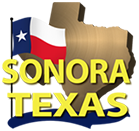Sonora, the county seat of Sutton County, is at the crossroads of Interstate Highway 10 (Exits 400 and 404), and U.S. Highway 277. U.S. 277 is the designated “Ports to Plains Corridor” and the future IH 27. It is 65 miles south of San Angelo and 90 miles north of the border with Mexico at Del Rio. Sonora is also a planned terminus (Exit 404) for a new interstate highway, IH 14, coming from the east.
This area of Texas was uninhabited, except for nomadic Indians and seasonal sheep drovers, until the late 1880’s when deep water well drilling technology rapidly changed the face of otherwise arid sections of the state. A well was drilled at what is now Sonora in 1889 by rancher, Charlie Adams, who promptly laid out the town and offered free town lots. By 1890, comprised of 18 houses, 3 stores, 2 livery stables, 2 hotels, a combined school house and Masonic lodge and 14 tents (and probably an uncounted saloon or two) and sporting a newspaper that is still in existence, Sonora became the county seat. This community of ranchers soon had mail connection to San Antonio, a bank and a new stone school house, which today is updated and still in use.
Growth was impeded by the lack of rail service in its early days; a freight haul to and from San Angelo took 6 days to two weeks depending on weather conditions. Livestock had to be driven north to rail-heads for access to markets. Finally, by 1930, Sonora was connected to San Angelo by a railroad providing it with vital transportation of its wool, mohair and livestock to lucrative markets until after WWII when better roads and the trucking industry made the local railroad obsolete.
Through the first half of the Twentieth Century, local prosperity continued to depend upon livestock and livestock products. In 1930 the Wool and Mohair Cooperative Marketing Association sold 2,738, 600 pounds of wool. By the early 1950’s, Sutton County was recognized for its great deer hunting opportunities making it a major hunting season destination, further enhancing its economy.
Sonora went from a population of 738 in 1904, to 1,009 in 1925 and by 1961 it reached 2633 as the prosperity of the country expanded after WWII and in the 1970’s climbed to around 6000. Sonora built its hospital in 1955, its first airport in 1957 and a series of flood control dams were completed in 1961. The hospital has been improved and expanded over the years to provide the community with first class facilities. The airport, too, has kept up with improvements to the runways and facilities. The wise decision made to install the flood control dams has made Sonora a safer place to live and prosper.
In 1960 the Caverns of Sonora majestic cavern of amazing live stalactites and stalagmites opened a short distance west of town. Later, the addition of the Old Sonora Ice House Museum and the Eaton Hill Nature Center & Preserve makes Sonora an important Texas tourist destination.
Oil and gas exploration and production has sustained Sonora for a long time; now it must look for new opportunities to carry it forward. A look at its assets will show there is plenty of promise for the future. By the late 1960’s Interstate Highway 10, extending from Jacksonville, Florida to Santa Monica, California is a positive influence on local business and holds promise for the future development of Sonora. Highway 277, which runs north and south through town, designated as the Ports to Plains Corridor from Canada to Mexico, which is planned to become IH27 and is another asset for Sonora. Another potential asset is the planned IH 14, which is planned to terminate into IH 10 at Exit 404. Our primary job drivers are oil and gas, transportation, tourism, agriculture and hunting. Sonora has a lot to offer!
Cherishing its rich history, Sonora continues to look forward, always looking for ways to make our community better and to increase our presence in the economy of Texas.
